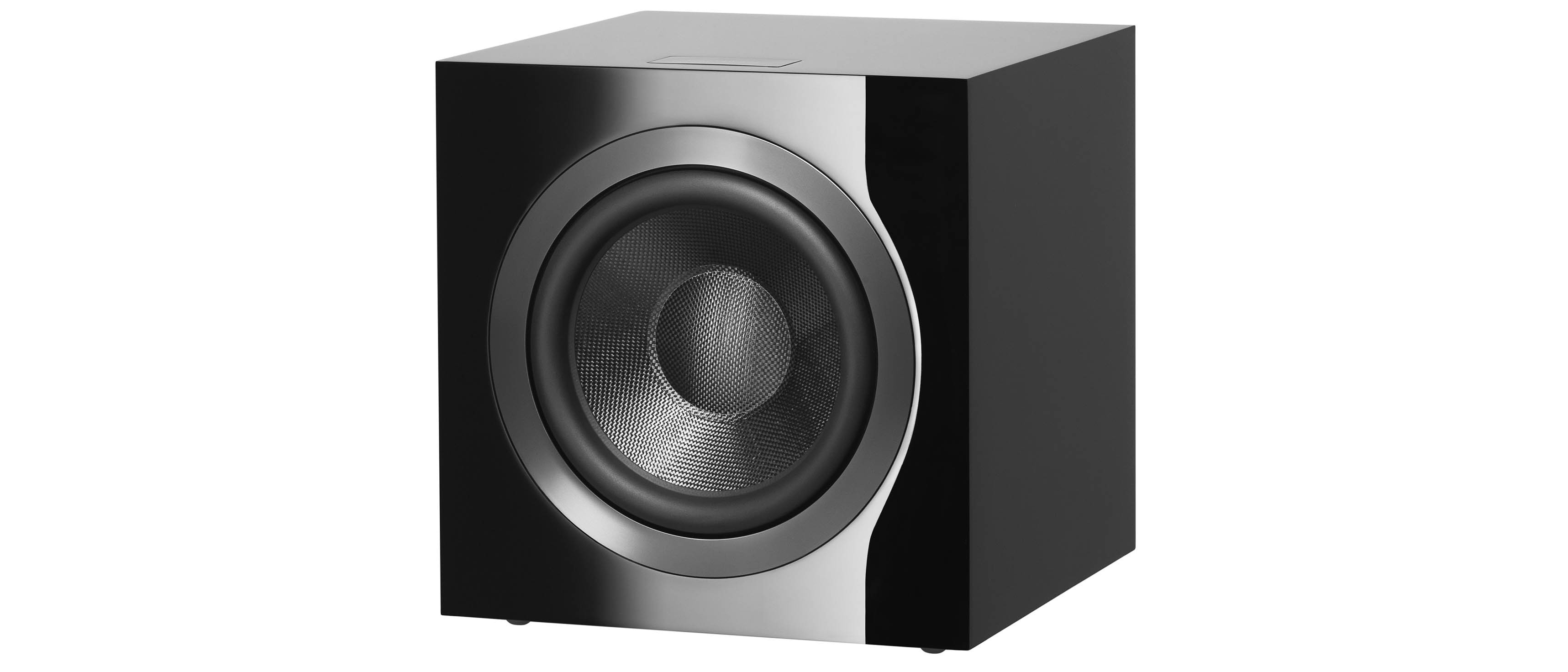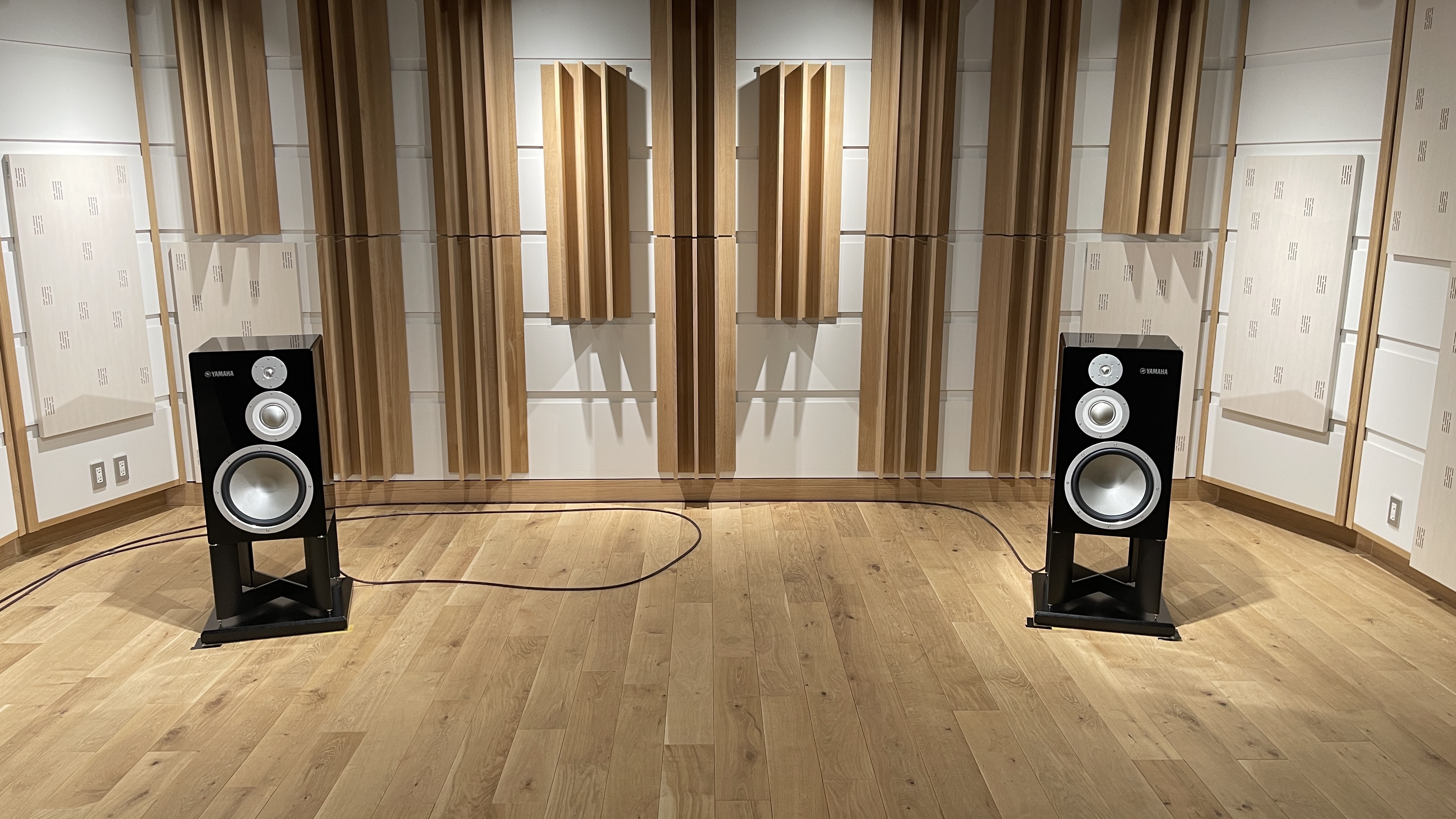What Hi-Fi? Verdict
A budget-priced subwoofer whose performance comes very close to that of B&W's fabulous DB3S.
Pros
- +
Great sound
- +
Easy to position
- +
Superb calibration controls
Cons
- -
Requires phone & app
- -
Limited Android support
Why you can trust What Hi-Fi?
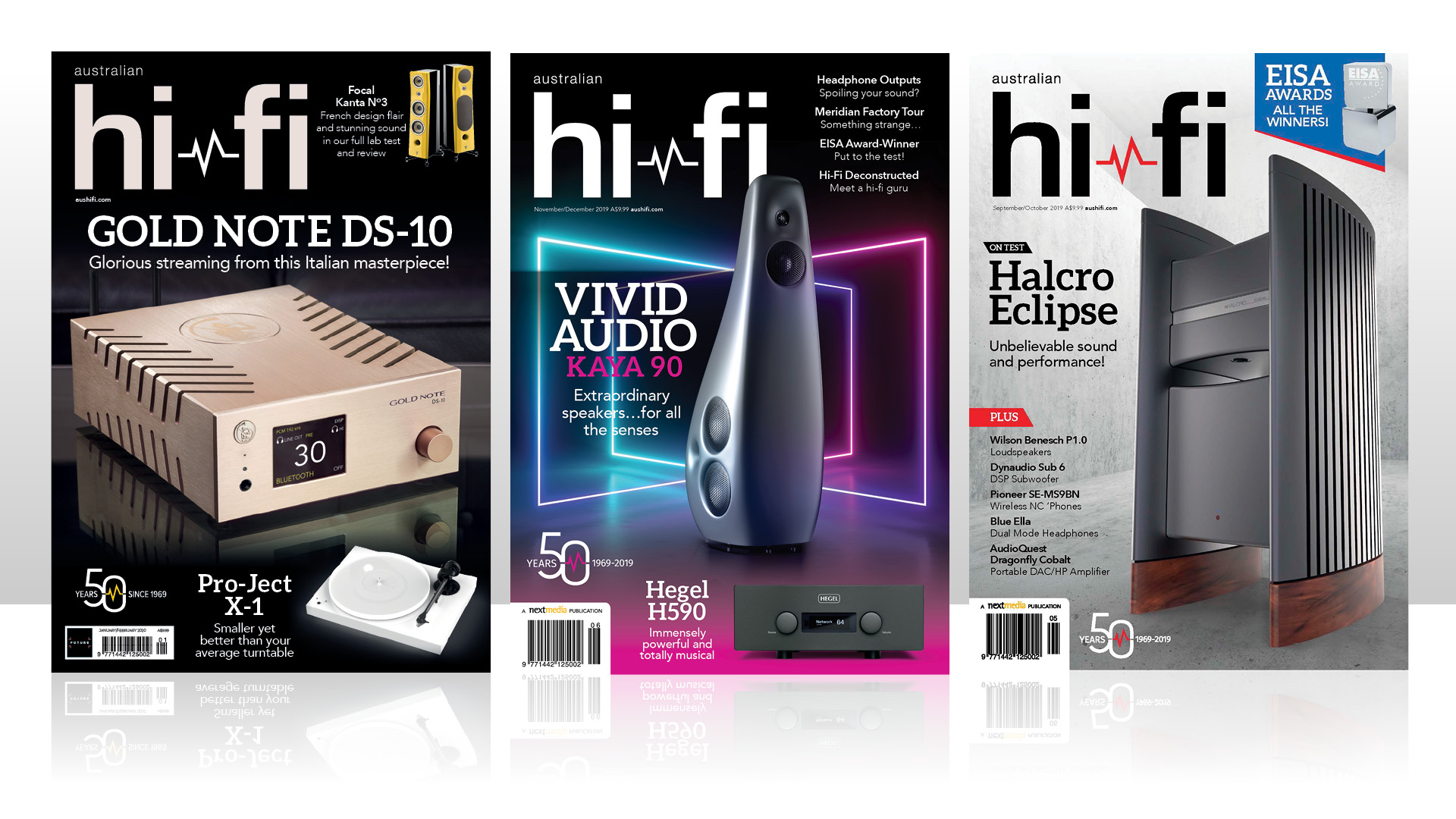
This review and test originally appeared in Australian Hi-Fi magazine, one of What Hi-Fi?’s sister titles from Down Under. Click here for more information about Australian Hi-Fi, including links to buy individual digital editions and details on how to subscribe.
B&W’s latest DB Series subwoofer, the DB4S, is something of an enigma. Although the lowest-priced model in the series, it’s not the smallest. So does it have the smallest bass driver? Nope, its low-frequency driver is actually larger than the one in the model in the range that’s above it. So maybe it has a lower-powered amplifier?
Again, nope. With a rated output of 1000-watts, the DB4S's amplifier has exactly the same rated power output as two other models in the range (though only half that of the range-topping DB1D, whose internal amplifier is rated at 2000-watts).
No, what the new DB4S does not have is the ‘dual balanced’ low-frequency driver configuration that’s an integral part of the design of B&W's DB1D, DB2D and DB3D models.
Equipment
As you have probably gathered, the DB4S subwoofer is something of a surprise appearance in B&W’s long-running DB range. The three subwoofers above it have followed the usual arrangement of having their cabinets scaled down in size with each successive model.
This means that the top-of-the range DB1D has an internal volume of 81 litres, the DB2D has an internal volume of 59 litres and the DB3D has an internal volume of 34.5 litres.
Because of these existing models and the progressively smaller cabinets I was expecting the DB4S to be even smaller again, but it is in fact larger than the DB3D, with an internal volume of 50 litres.
A clue to the enigma lies in its model number.
The three other subwoofers are all double-driver subwoofers, fitted with two low-frequency drivers working in what B&W calls a ‘dual balanced configuration.’ This is where the ‘DB’ comes in... or so I previously thought. Now it appears that it’s the ‘D’ at the end of the model number that signifies there are two low-frequency drivers in the cabinet.
So although this new DB4S is a part of B&W’s ‘DB’ subwoofer range, the DB4S has only a single driver. And that single driver is actually larger than the driver in the DB3D. In fact, it’s the same driver that’s used in the DB2D: a 250mm diameter Aerofoil-coned unit.
The trick here is that with a diameter of 250mm, the driver in the DB4S has an effective cone area of around 490cm², and it’s this figure (along with the driver excursion) that dictates how effectively the driver will deliver bass frequencies into your living room. But because the DB3D has two drivers, the total cone area is around 628cm², so it can actually push more air than the DB4S.
B&W is one of the few manufacturers in the world that makes its own subwoofer cones, and the one in the DB4S is a real beauty! The cone is made from a material B&W originally developed for its flagship 800 Series Diamond loudspeaker.
The construction of the cone is very similar to that originally used for B&W’s ‘Rohacell’ cones, which sandwiched a foam core between two skins of woven carbon-fibre; however, unlike the ‘Rohacell’ driver, whose foam core is the same thickness everywhere across the cone, the core in the ‘Aerofoil’ cone is not constant over the cone’s diameter, but varies depending on the distance from the point at which it attaches to the voice coil former. In fact the curvature is not dissimilar to that of an aeroplane wing – which is, no doubt, the reason B&W calls them ‘Aerofoil’ drivers.
B&W says of its Aerofoil cones: “these light, ultra-stiff drivers resist bending and flexing far longer than conventional cones, delivering controlled bass with outstanding precision.”
Driving the Aerofoil cone is a custom version of a 1000-watt Class-D amplifier from Dutch amplifier specialist Hypex, whose Class-D modules can be found in a great many of the world’s most famous powered subwoofers… and in quite a few of the world's most famous audio amplifiers as well.
The founder of Hypex was Bruno Putzeys, sometimes called the modern ‘father’ of Class-D design due to his designs both for Hypex and for Philips, where he worked prior to founding Hypex.
Putzeys was the first to best-solve the problems that prevented Class-D amplifiers from being used in high-performance products, even though the Class-D concept had been around since 1958.
Because of the many myths that surround Class-D, I should point out that the ‘D’ in Class-D does not stand for ‘digital’. In fact all Class-D amplifiers are analogue amplifiers, and when properly implemented (and here I must stress ‘properly implemented’), Class-D amplifiers have many significant advantages over the more usual Class-A and Class-AB designs, such as higher power output, lower power consumption, higher thermal efficiency, smaller physical size and more.
If the B&W DB4S is sounding pretty special to you so far, just wait until you read the next sentence. It does not have any physical controls.
Take a look around the back of a DB4S and you’ll find a pair of balanced inputs (via XLR), a pair of line-level RCA inputs (which are labelled as ‘phono’, but no, you cannot connect your turntable directly to them), a pair of 12V trigger inputs, for remote switching operations, an RS-232 connector to facilitate the DB4S being used in remote-control home automation systems, and a 240V input socket along with its associated power/standby button. That’s it.
There is no volume control, no crossover frequency selector... none of the controls you’d normally expect to find on a subwoofer… except for a single mains power switch with a chameleon LED on it that glows red for standby and green when on.
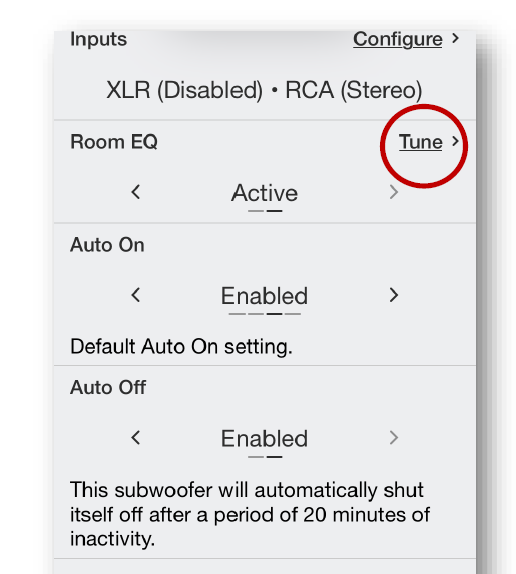
But despite the paucity of controls on the subwoofer itself, owners will have total control over the DB4S, because all functions can be accessed via your mobile phone, with B&W providing the necessary apps for both iOS (Version 10 and later) and Android (Version 5 and later) phones.
As well as ‘total control’ (over volume, crossover frequency, phase, high-pass filter slope and more), B&W’s app also allows you to use your phone’s microphone to help adjust the frequency response of the subwoofer to best suit both your listening room and your main speakers.
But if you don’t like the calibrated frequency response, you can use the built-in five-band equaliser to adjust the sound to your liking, maybe by adding a bit of extra ‘kick’ in the ultra-lows. And if you’d rather not fuss around with calibrations at all, you can also use the ‘ready to roll’ frequency response to which the DB4S defaults.
Calibration settings are stored in memory, so you don’t lose one when you switch to another, and so you can always switch back if you prefer – or switch between settings depending on whether you’re listening to music or watching a movie, or to different types of music and movies.
However, there is a much easier way to have settings that switch between, say, music and movies, because if you connect, say, your hi-fi amplifier to the XLR inputs and your home theatre receiver to the RCA inputs, then you can program different settings to be used for each of them. Very neat!
Although both iOS and Android phones can be used to operate the DB4S, the auto-calibration process is (at the time of writing) supported only in Android by the following phones: Samsung’s Galaxy S7, S7 Edge, S8 and S9, and Google’s Pixel & Pixel 2. If you don’t have one of these phones, B&W suggests that, since it only needs to be done the once, you should borrow a compatible phone to do the calibration, then after use your own phone for day-to-day control of the subwoofer.
B&W provides two sets of feet with each DB4S. There's a set of four small rubber bullet-shaped feet for use on hard surfaces and a set of four spiked feet for carpeted surfaces. It is important to use these feet, firstly because they will isolate the subwoofer's cabinet vibrations from the floor and secondly because they enable the airflow necessary to cool the internal amplifier.
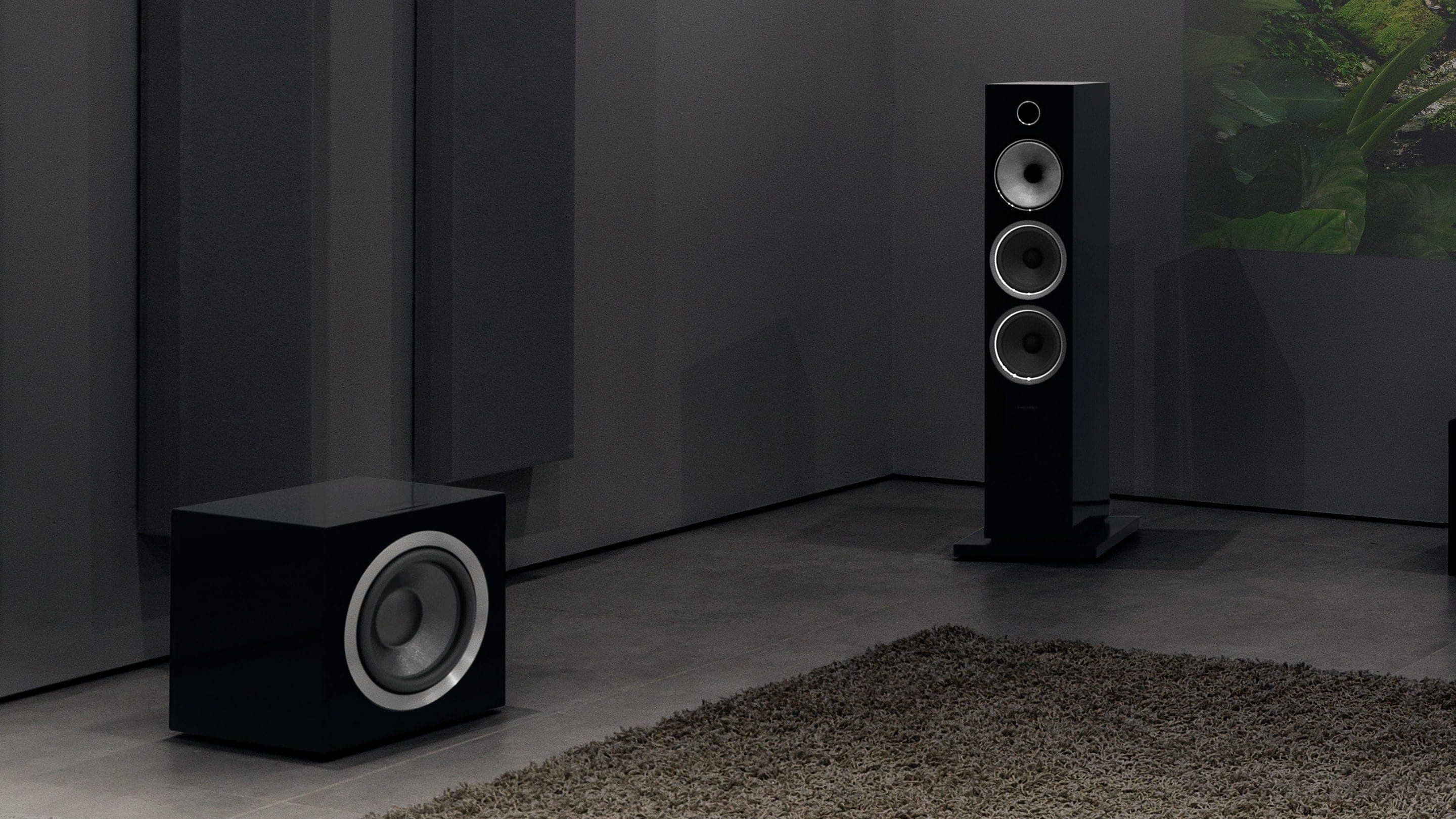
The DB4S is available in a number of different finishes. It comes in B&W’s usual superb piano lacquer finish in either gloss black or gloss white, plus it’s also available in a real Rosenut wood veneer. And, whereas once B&W’s DB-series subwoofers came with only a black grille, you can now choose between black or grey. And, in a great design move, the grille now attaches to the baffle magnetically, so there are no pegs to break off and, if you prefer to use the DB4S without a grille, there are no unslightly fixings to be seen on the baffle, just that impressive-looking driver and that flawless painted finish.
B&W's DB4S measures 377x360x368mm (HWD) and weighs 26kg. It draws less than 0.5-watts in standby mode, so the only time you'd bother actually physically switching it off is when you go away on holiday for more than a week.
Sound
One advantage of having only a single bass driver, no bass reflex port and no requirement to access physical controls is that of all the subwoofers in B&W’s DB Series, this new DB4S is the easiest to position, not least because you can push it right back against a wall.
But I would recommend you at least evaluate all the ‘best’ positions to put the subwoofer by using the article at www.tinyurl.com/WHFsubsetup, and put your DB4S in one of the recommended positions before running B&W’s calibration process because although equalisation is a great tool, it’s not a universal panacea. And, as with all subwoofers, it’s best if the subwoofer is located roughly in the same plane as your left and right speakers, or slightly behind that plane.
Calibration will be much easier if you are integrating the DB4S with B&W loudspeakers because presets for most of these are pre-programmed into the DB Subwoofer app. If you are not using B&W speakers, you will have to choose the ‘Other Speaker’ setting, which allows you to set low-pass frequency (25Hz to 150Hz), crossover slope (12 or 24dB/octave) and phase (0–270°). All this should be done before you run the calibration.
I auditioned the B&W DB4S with stereo music that covered everything from Beach Boys to Beethoven, and in multi-channel using movies that included comedies, period dramas, science fiction and action. I also partnered it with several different loudspeakers that included a pair of small two-way stand-mounters and a largish pair of three-way, four-driver floorstanders.
No matter what music I played through it, or which speakers I paired with it, I was entirely satisfied with the performance of the B&W DB4S. It delivered rich, full-bodied bass throughout my sessions, and showed no signs at all of overload even when played more loudly than would usually be warranted in a home environment.
I could not hear any distortion when listening at any sensible volume level, and the DB4S’s frequency response was as smooth as silk, being even and controlled with no undue emphasis on any specific region of frequencies. It was all just smooth, controlled bass from the lowest audible frequencies up to where the main speakers took over the sonic responsibilities.
Verdict
The B&W DB4S is an object lesson in the swings and roundabouts of subwoofer performance. In building this new DB4S, B&W has been able to deliver a budget-priced subwoofer whose performance comes very, very close to that of its fabulous DB3S, though to take advantage of the significant cost saving, you will need to accept that the cabinet is larger. But the cabinet is not all that much larger, and B&W’s cabinet finishes are so attractive you’ll likely be proud that it’s a part of your room’s décor.
And while you can potentially get a more extended bass response and higher volume levels from the larger models in B&W’s DB subwoofer range, you will really only be able to take advantage of this potential if your room is much larger than the average Australian lounge room, because low-frequency sound waves are so long that you they need space to properly propagate.
I am happy to be able to conclude this review with the statement that, without any shadow of a doubt, the B&W DB4S is yet another great subwoofer from this great British company*.
*Although B&W is a British company and has research, development and manufacturing facilites in the UK, it is now owned by Canadian company Sound United, which is also in control of such brands as Denon, Marantz, Polk Audio.
Full lab test results
The in-room frequency response of the B&W DB4S subwoofer measured by Newport Test Labs is shown in Graph 1, below:
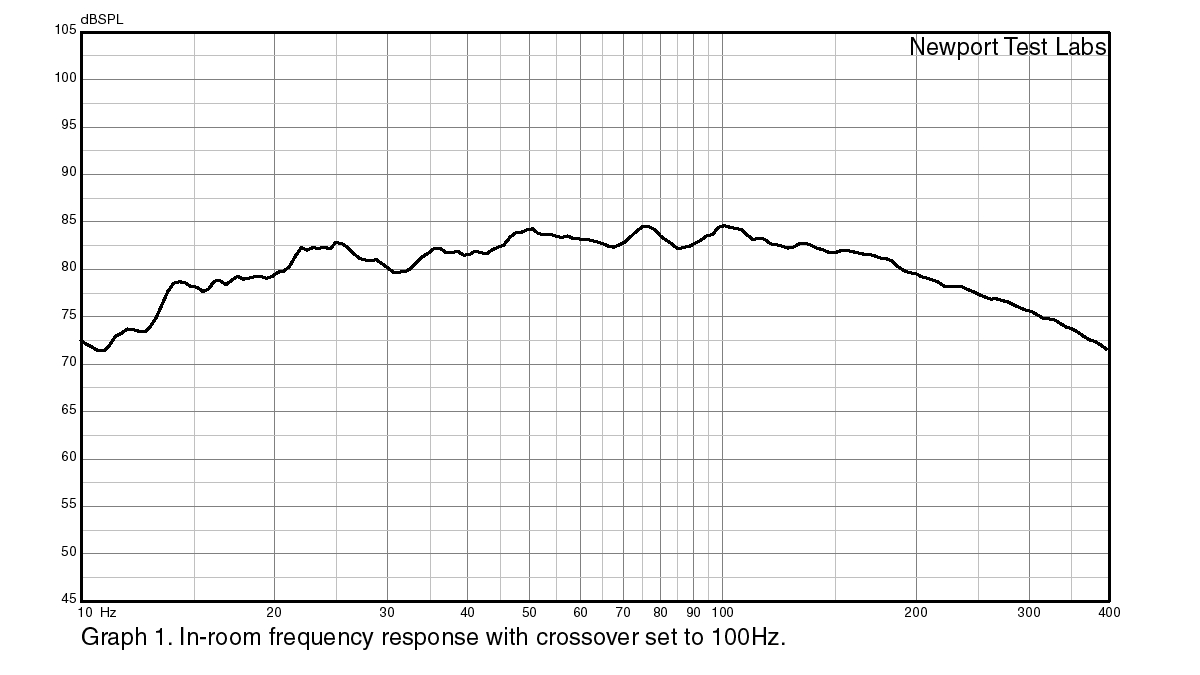
You can see that the in-room frequency response remains within a 5dB envelope from 20Hz right up to 200Hz, which is an outstanding achievement. Using a more conventional ±3dBdB envelope, this response is 14Hz–280Hz ±3dB.
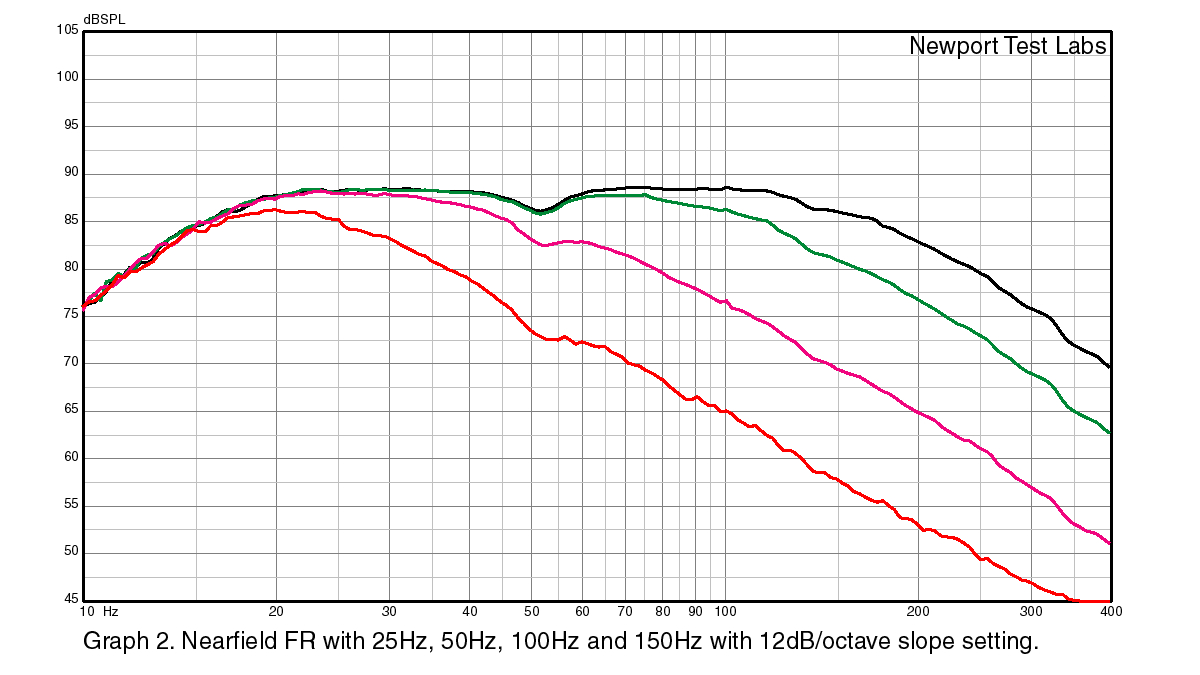
Graph 2 (above) shows the frequency response of the DB4S for four different settings of the crossover control and 12dB/octave filter slopes when measured by Newport Test Labs using a nearfield microphone technique that essentially delivers the response you'd expect to get in an anechoic chamber.
All traces were measured after the subwoofer's response had been equalised using B&W's Android app. The black trace shows the frequency response for the 150Hz setting and you can see that the response extends from 14Hz to 200Hz ±3dB. This is an excellent result.
The green trace on Graph 2 shows the response of the DB4S at the 100Hz 12dB/octave setting. You can see that, as you'd expect from the setting of the crossover control, the response rolls off earlier, to be 3dB down at around 120Hz.
The pink and red traces on Graph 2 show the accuracy of the DB4S's crossover calibration, because when it's set to 50Hz (purple trace) the response is 3dB down at 45Hz and when it's set to 25Hz (red trace) the response is 3dB down at 30Hz. These are certainly 'near enough' to the design target at these low frequencies.
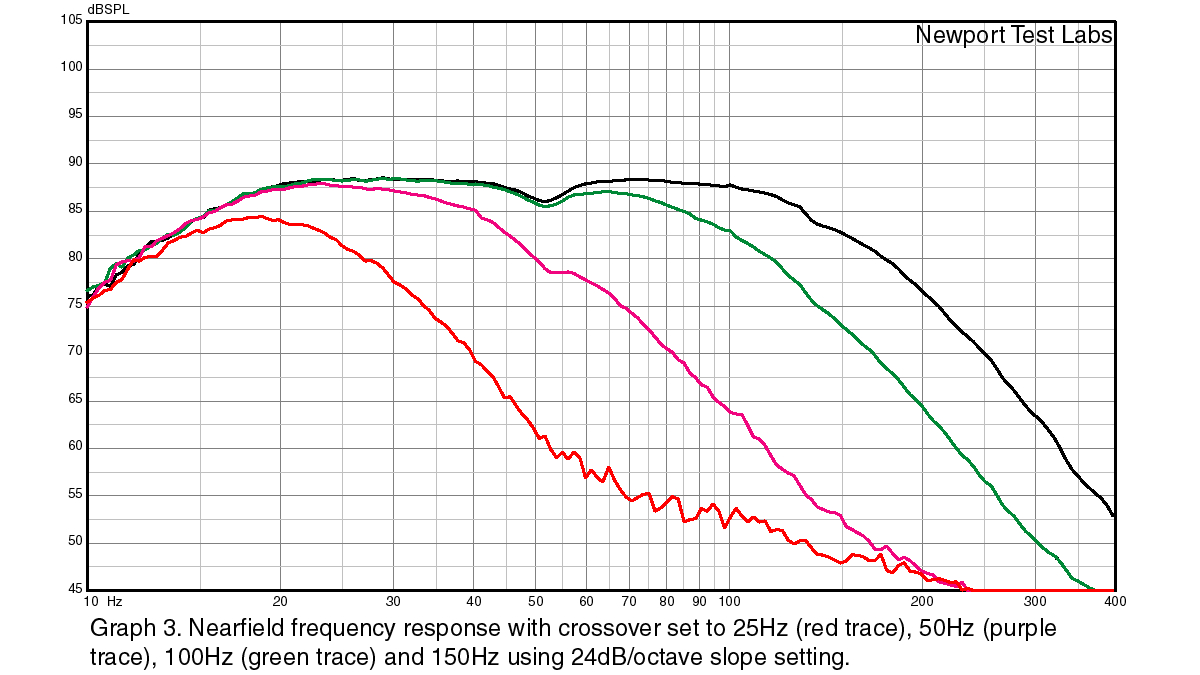
Graph 3 is essentially the same as Graph 2, except that Newport Test Labs set the crossover slope at 24dB/octave, rather than at 12dB/octave as in Graph 2. You can see the steeper roll-offs, and this time, the 150Hz trace is exactly 5dB down at 150Hz, the 100Hz trace is exactly 5dB down at 100Hz, the 50Hz trace is exactly 5dB down at 50Hz and the 25Hz trace is 3dB down at 25Hz.
Because of the amount of control you have over the crossover frequencies, the crossover slopes and, of course, the five-band equalisation, these responses show that you'll be able to properly integrate the DB4S with any main speakers, no matter how large or small they may be.
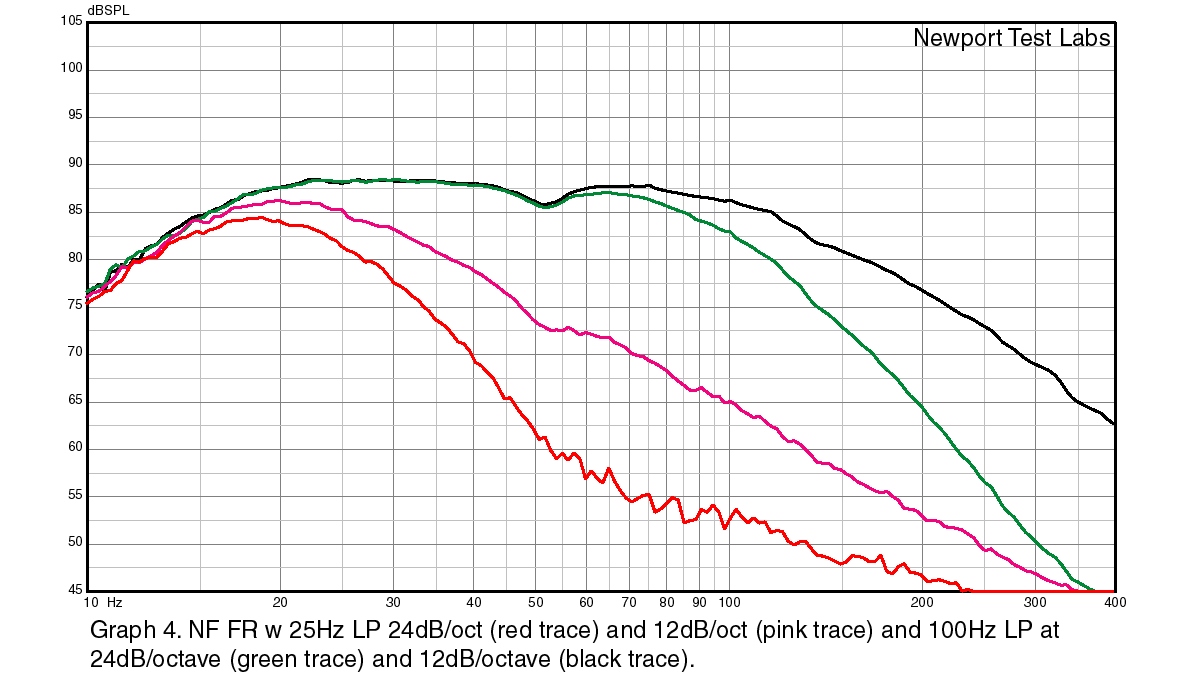
The difference in roll-off slopes for the B&W DB4S subwoofer's 12dB/octave and 24dB/octave settings is clearly shown in Graph 4 for two frequencies: 25Hz and 100Hz.
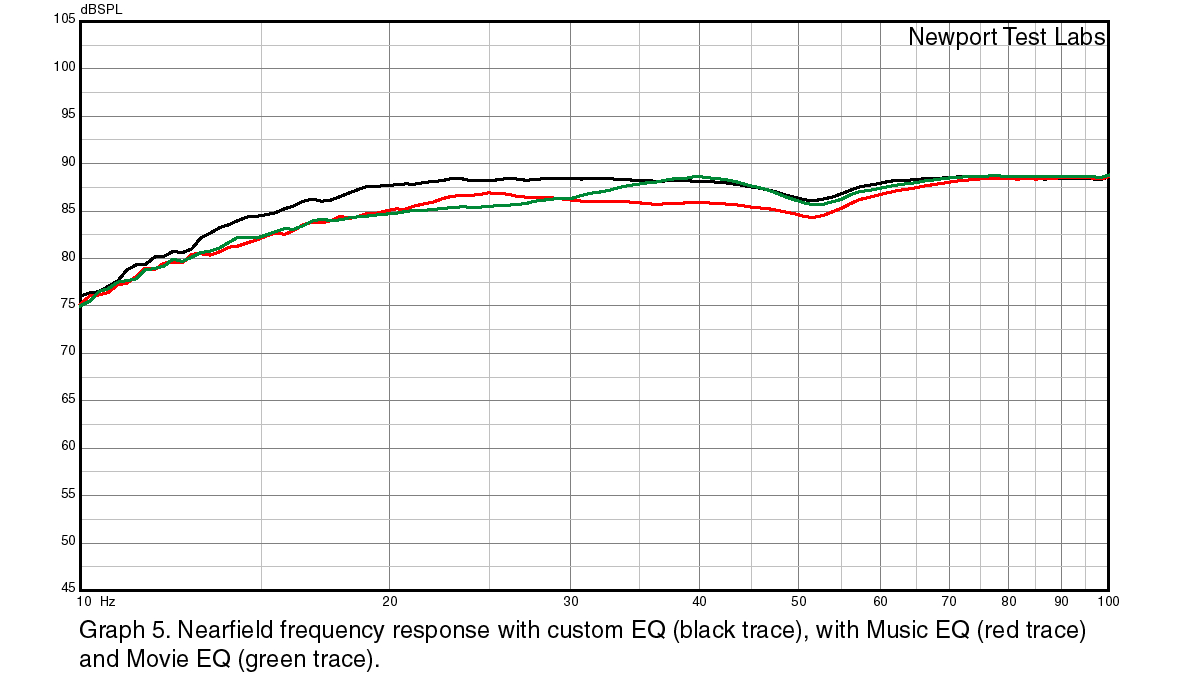
Graph 5 shows the effect on the low-frequency response of the DB4S of the two pre-set equalisation filters, Music and Movies. The black trace shows the very low-frequency response with a custom EQ setting but without Music or Movies EQ applied.
You can see that the Music EQ setting rolls off the lowest bass a little earlier at around 50Hz, while the Movie EQ setting rolls off at around 35Hz. The effect the Music and Movie EQ settings has on the DB4S's response is so subtle (less than ±1.5dB between 20Hz and 200Hz) that I would imagine that in many rooms it would barely be audible.
It is obvious from Newport Test Labs' tests that the frequency response of the B&W DB4S is outstandingly good, with low-frequency extension one rarely sees in such a small subwoofer.
This performance, along with the excellent control enabled over both the crossover frequency and the crossover slopes, and the inbuilt five-band equaliser mean that you'll be able to use it to good effect with either very small bookshelf speakers, or very large floorstanding loudspeakers to increase the quality and depth of the bass response of your system, be it two-channel or multi-channel. Overall, excellent performance from an outstanding design.
Australian Hi-Fi is one of What Hi-Fi?’s sister titles from Down Under and Australia’s longest-running and most successful hi-fi magazines, having been in continuous publication since 1969. Now edited by What Hi-Fi?'s Becky Roberts, every issue is packed with authoritative reviews of hi-fi equipment ranging from portables to state-of-the-art audiophile systems (and everything in between), information on new product launches, and ‘how-to’ articles to help you get the best quality sound for your home. Click here for more information about Australian Hi-Fi, including links to buy individual digital editions and details on how best to subscribe.
